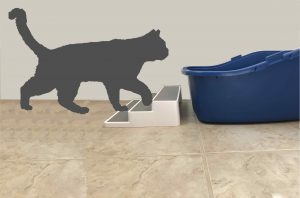Osteoarthritis, a degenerative joint disease (DJD), is very common in domestic cats. But we seldom hear about cat arthritis treatment. Unfortunately, cats possess a strong instinct to hide signs of pain, so this condition often goes undetected and untreated, leaving cats to suffer in silence. Signs and symptoms are frequently misinterpreted, misunderstood, or simply attributed to “getting old.” Tragically, senior cats may be abandoned, surrendered to shelters, or euthanized as a result of their “problem behavior.” Research published in the Journal of Applied Animal Welfare Science found that “inappropriate elimination” by cats was the most frequent behavioral reason people cited for requesting euthanasia for cats.5
Help your cat by learning to recognize signs that could indicate your cat is dealing with pain. You can take simple steps to greatly improve your cat’s comfort and quality of life.
How Does Osteoarthritis Impact My Cat?
Osteoarthritis is a degenerative condition in which cartilage, the smooth, slippery substance between joints, deteriorates. Normal, healthy cartilage supports smooth action of joints and helps absorb the shock of movement.
But when cartilage breaks down and wears away, the bones can grind against each other, causing pain, swelling, and making movement difficult. In addition, the joint may lose its shape over time, and bone spurs may grow on the joint edges. Previously normal activities, like jumping on furniture, climbing stairs, or even accessing the litter box can become very painful. Naturally, if an activity causes pain, many cats will try to avoid repeating that action. This is how some litter box avoidance issues begin.

Small steps can help cats suffering from joint pain more easily access their litter boxes. The hip is one of the joints most frequently affected.
Here’s a helpful short video, courtesy of WDDC, showing how arthritis affects cats and dogs:
How Common is DJD?
DJD is very common, and the likelihood your cat will be affected increases with his or her age.
In a study6 published in Veterinary Surgery, researchers randomly selected 100 cats, equally distributed across 4 age groups. The cats’ age group ranges were 0-5, 5-10, 10-15, and 15-20 years old. Surprisingly, 92% of the cats showed radiographic evidence of degenerative joint disease. However, the researchers found a significant association between a cat’s age and DJD. For each 1-year increase in cat age, the expected total DJD score increased by an estimated 13.6%.
In another study,4 published in the Journal of the American Veterinary Medical Association, researchers studied 100 cats over 12 years of age. Their findings revealed that radiographic evidence showed 90% of the cats suffered from degenerative joint disease. The researchers concluded that degenerative joint disease was detected radiographically in most geriatric cats and may be an overlooked cause of clinical disease.
Signs to Watch For
Observe your cat more closely, and learn to recognize subtle signs that indicate your cat may be suffering from joint pain. You know your cat’s activities and habits better than anyone else. Even for experienced veterinarians, diagnosis through physical examination can be difficult. Your input and description of behavior changes will be extremely useful to your veterinarian.
Be aware that affected cats do not typically exhibit lameness.1 Because joints on both sides of the body are usually affected, cats compensate and appear to walk normally.7
See your veterinarian if you notice:
• Loss of appetite / Weight loss
• Change in activity level
• Depression, hiding, or withdrawal from social interaction
• Avoiding being touched
• Increased vocalization
• Poor grooming habits or over-grooming of specific (possibly painful) spots
• Urination or defecation outside litter box
• Reduced ability to jump on and off objects
• Change in general attitude
How to Help Your Cat
Pharmaceutical options for cat arthritis treatment are limited, due to side effects and safety issues. You can, however, easily implement changes to improve your cat’s comfort and daily quality of life.
For instance, in the March 2018 issue of Veterinary Sciences, researchers published the results of their reviews of numerous veterinary trials of dogs, cats, and horses supplemented with Greenshell mussel (GSM; Perna canaliculus) preparations.2 The researchers concluded that adding GSM to animal diets alleviated feline degenerative joint disease and arthritis symptoms, as well as chronic orthopedic pain in dogs.
VetriScience Laboratories makes an excellent advanced joint support product for cats, GlycoFlex® Stage 3 Feline Bite-Sized Chews. It combines Perna canaliculus with other effective ingredients like glucosamine and MSM, for serious joint support in a tasty, chewable nugget. I have started my own 13-year old cat on these, and she loves them.
Ways to help:
(1) Fish oil and glucosamine/chondroitin supplements (We like Nordic Naturals Omega-3 Pet for Cats and VetriScience Glycoflex line)
(2) Weight loss for overweight cats (Tip: Replace some of the calories in your cat’s canned food by adding a small amount of water — read more here)
(3) Help your cat groom by gently brushing him or her daily. It may be painful for your cat to reach all areas. Be aware that some areas may be sensitive to touch.
(4) Increase exercise and play
(5) Easier entry/exit to litter pans
- Purchase litter boxes with low sides OR
- Cut down high sides OR
- Provide mini-steps or construct a ramp to ease entry to the litter box
- Locate litter pans on the ground floor of your home; don’t force your cat to climb stairs to reach litter boxes
(6) Elevate food and water bowls so that your cat is not forced to bend at the elbows to eat or drink
(7) Provide soft, supportive bedding
(8) Acupuncture treatment by a licensed practitioner
While it’s very likely osteoarthritis will affect your cat someday, it doesn’t have to limit your cat’s quality of life. There are so many simple ways you can improve daily life for your aging cat, and enjoy many more contented years ahead together.
References
1 Bennett D, Zainal Ariffin SM, Johnston P. Osteoarthritis in the cat 1. How common is it and how easy to recognize?. J Feline Med Surg 2012;14:65–75. PMID: 22247326 DOI: 10.1177/1098612X11432828 [PubMed]
2 Charles T. Eason, Serean L. Adams, Jonathan Puddick, Donato Romanazzi, Matthew R. Miller, Nick King, Sarah Johns, Elizabeth Forbes-Blom, Paul A. Hessian, Lisa K. Stamp, and Michael A. Packer. GreenshellTM Mussels: A Review of Veterinary Trials and Future Research Directions. Veterinary Sciences. 2018 Jun; 5(2): 36. PMID: 29584640 [PMC]
3 Cornell Feline Health Center – Is Your Cat Slowing Down?
4 Hardie EM, Roe SC, Martin FR. Radiographic evidence of degenerative joint disease in geriatric cats: 100 cases (1994-1997). Journal of the American Veterinary Medical Association. 2002 Mar 1;220(5):628-32. PMID: 12418522 [PubMed]
5 Kass PH, New, JC Jr., Scarlett JM, Salman, MD, Understanding Animal Companion Surplus in the United States: Relinquishment of Nonadoptables to Animal Shelters for Euthanasia, J Applied An Welfare Sci, 4(4), 2001:246. DOI: 10.1207/S15327604JAWS0404_01
6 Lascelles BD, Henry JB 3rd, Brown J, Robertson I, Sumrell AT, Simpson W, Wheeler S, Hansen BD, Zamprogno H, Freire M, Pease A. Cross-sectional study of the prevalence of radiographic degenerative joint disease in domesticated cats. Veterinary Surgery. 2010 Jul;39(5):535-44. doi: 10.1111/j.1532-950X.2010.00708.x. [PubMed]














